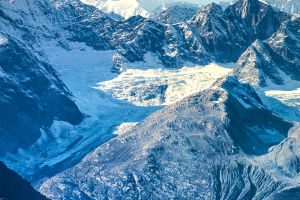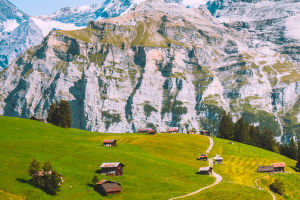Grasslands are biomes that cover a significant portion of the Earth's land surface, occupying about 25% of the total land area. They are found in various parts of the world and are characterized by an abundance of grasses and other herbaceous plants with few trees.
Grasslands are situated between two extremes of the environmental gradient - forests and deserts.
Forests are typically found in areas with sufficient moisture that can sustain the growth of tall, dense vegetation, primarily trees.
On the other hand, deserts are located in regions where water is scarce, making it difficult to support permanent vegetation.
Grasslands, therefore, are situated in the middle ground, where the environment is not too wet for trees nor too dry to prevent vegetation from thriving.
The development of grasslands can be traced back to the Cenozoic era, specifically during the dry and cool phases of the global climate. The evolution of graminoids, the family of grasses, also occurred during this period.
Fossils from the Cenozoic era reveal a gradual climatic change, where several vegetation types, including grasslands, mangroves, and deserts, replaced the tropical rainforests in central Australia over the past 50 million years.
In some areas, grasslands expanded to near-modern sizes only two million years ago during the ice age, a period of extreme dryness and cold in the temperate north.
Grasslands come in various types and occur in different regions worldwide. In some high mountains or above the high timberline, grasslands are the dominant vegetation, as it is too cold for trees to grow.
Clumped grasslands, where grasses develop coiled mats of rhizomes, are typical in wet and cold regions of the southern hemisphere, while tufted grasslands are found in different latitudes.
In the tropics, tufted grasslands are located above the timberline in some high mountains, such as in New Guinea and East Africa.
In the higher latitudes of the Antarctic Sea, clumped grasslands form the vegetation of the Subantarctic Islands.
Bush grasslands are also common in colder regions such as New Zealand and the southernmost tip of South America.
However, not all natural grasslands arise from climate-related environments.
In some areas, woody plants cannot grow due to other factors, allowing grasses to spread in abundance.
Seasonal flooding or inundation is one of these factors that create and maintain large grasslands in parts of the subtropics where the season is distinct and in smaller areas elsewhere.
The Pantanal in Mato Grosso, Brazil, is an excellent example of seasonally flooded subtropical grasslands.
In an area of 140,000 square kilometers (54,000 square miles), grasslands expand during half the year, shallow wetlands expand during the other half, and small patches of woodland are confined to short posts that do not flood during the wet season.
In other places where the climate is suitable for forest growth, infertile or shallow soils can prevent trees from growing, leading to the development of grasslands.
Grasslands are an important ecosystem that provides various ecological, economic, and social benefits.
Ecologically, grasslands are home to a diverse range of plant and animal species, including many endangered and threatened species.
Grasslands also play a crucial role in carbon sequestration, helping to mitigate the effects of climate change.
Economically, grasslands are an essential source of food for livestock, which supports the agricultural industry.
Additionally, grasslands provide opportunities for recreation, such as hiking, birdwatching, and hunting.
However, grasslands face significant threats from habitat loss due to agricultural and urban development, overgrazing, invasive species, and climate change.
Protecting and restoring grasslands is crucial for maintaining biodiversity, supporting agriculture, and mitigating climate change.
Grasslands are a critical biome that occupies a significant portion of the Earth's land surface.
They are located between forests and deserts, in areas where the environment is not too wet for trees nor too dry to prevent vegetation from thriving.
Grasslands come in various types and occur in different regions worldwide, from high mountains to subtropical regions.
Their development can be attributed to the dry and cool phase of the global climate during the Cenozoic era.
Although not all grasslands arise from climate-related environments, they are an essential ecosystem that provides habitat for various animal species, carbon sequestration, and human benefits such as grazing land for livestock.


